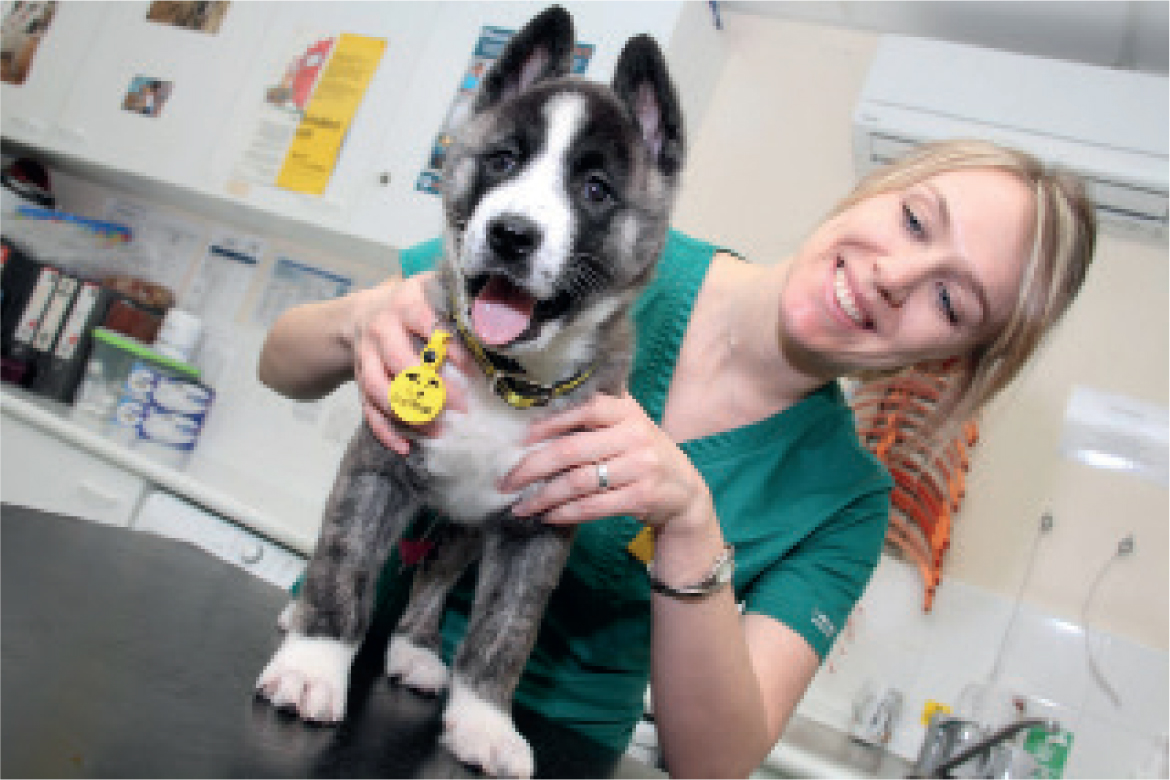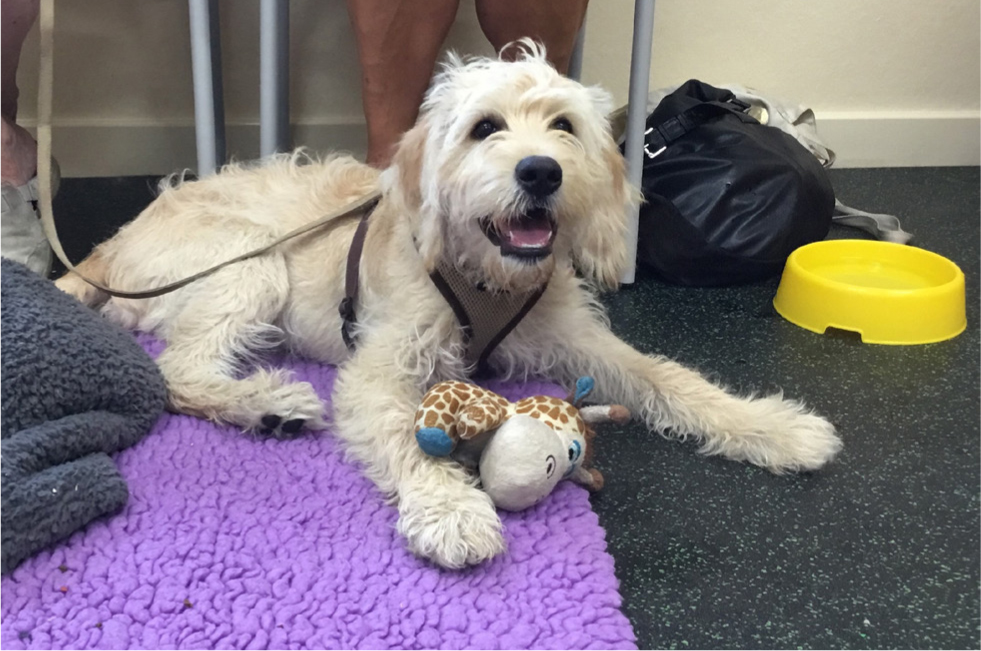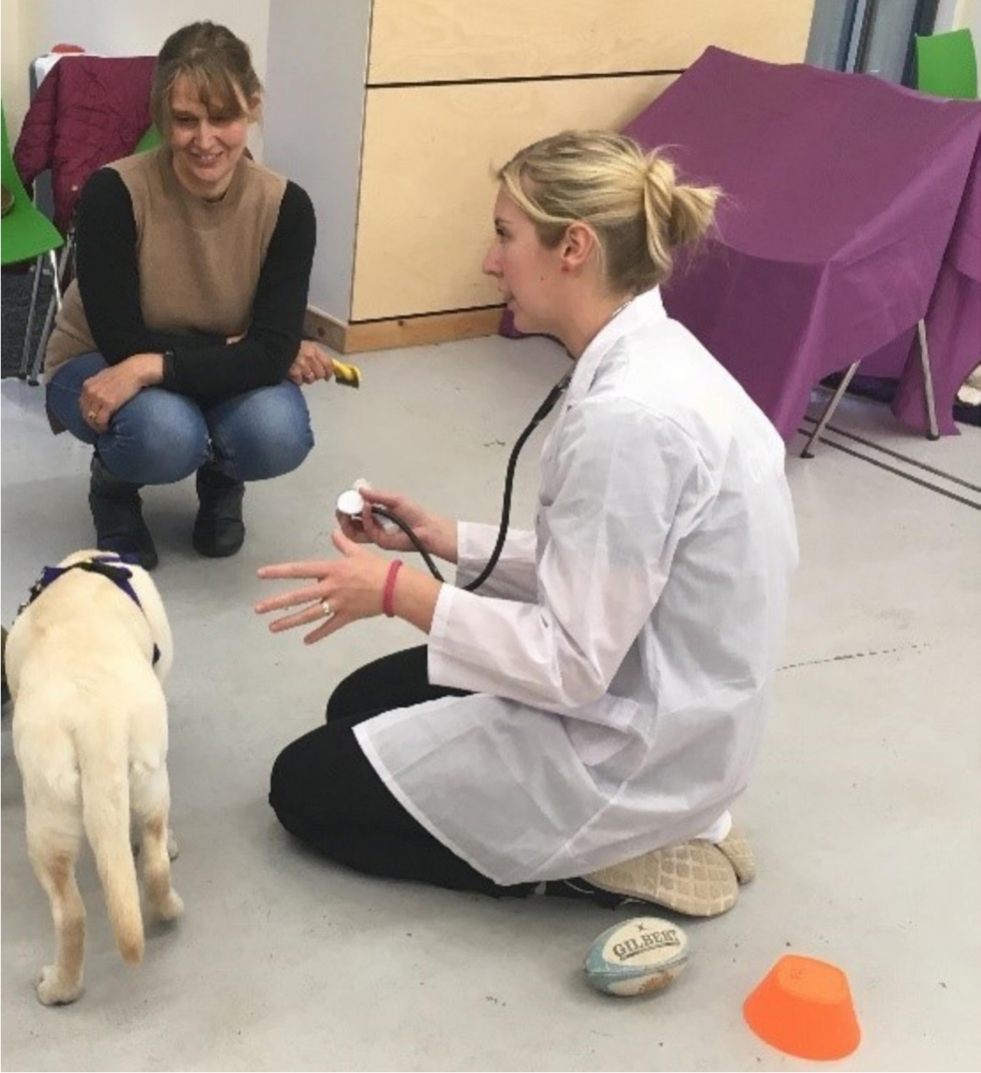The ‘stress response’ is a term commonly applied to an individual's physiological, psychological or behavioural reaction to any perceived threat to wellbeing. The hypothalamus–pituitary–adrenal axis and the sympathetic nervous system are activated (Notari, 2009), thus any stimulus that triggers this bodily change could be considered a stressor.
Ryan (2021) raised the increasing importance of meeting the emotional needs of veterinary patients. This is highlighted by the success of the Cat Friendly Clinic Scheme (https://catfriendlyclinic.org/), Rabbit Friendly Vet Scheme (https://rabbitwelfare.co.uk/) and the launch of the Dog Friendly Clinic Scheme (dogfriendlyclinic.org.uk) this year (Figure 1). These accreditation schemes recognise that vet visits can be fearful or distressing experiences for both pet and owner, and advocate for making small changes within the clinic that can make the vet visit calmer and easier for everyone.

This article will focus on identifying why the veterinary experience can cause distress for our canine patients and will include:
- Identifing stressors during the veterinary visit
- Situation/trigger stacking
- How dogs learn.
Second, the article will highlight ways to reduce stress during the veterinary visit, including the:
- The clinic environment
- Clinic–canine interactions
- Owner education.
Why the veterinary experience might cause distress for canine patient
Identifing stressors during the veterinary visit
Identifiying potential stressors, then subequently implementing reduction strategies, is the cornerstone to improving canine welfare in the clinic (Edwards et al, 2019).
Veterinary clinic reception and waiting area
Mariti et al (2015) found that 53% of dogs showed four or more behavioural signs of stress within the waiting area.
Riemer et al (2021) suggested that the presence of conspecifics or other species both inside and outside the clinic can cause stress, which may be a result of:
- Pheromones from other dogs, potentially communicating threat or distress (Janssenswillen et al, 2021)
- Unsolicited interactions from other owners, animals, or the clinical team, perhaps being directly approached, stared at or touched
- The sights, sounds and smells of other animals who might be unwell, anxious, excited or unsettled
- An underlying fear of unfamiliar animals and/or people.
Consultation room
The consultation room (Figure 2) can be a cause of fear for canine patients (Mariti et al, 2016; Riemer et al, 2021) for various reasons:

- The consulting area, as well as the equipment and vet staff within it, can be associated with previous negative experiences (Doring et al, 2009)
- Not providing dogs with an opportunity to investigate the environment before examination (Lloyd, 2017)
- Being lifted onto an examination table (Doring et al, 2009)
- Being handled and examined by an unfamiliar person
- Handling and any form of restraint or necessary medical intervention resulting in discomfort and/or pain (Lloyd, 2017).
Hospitalisation
Vaisanen et al (2005) and Juodžente et al (2018) demonstrated that hospitalisation can be particularly distressing. Reasons for this include:
- Being confined within an unfamiliar kennel without the social support of owners and security of home surroundings
- Inability to evade interaction
- Noise exposure.
Situation stacking
Situation stacking (also called trigger stacking or stressor stacking) is where short-lived, separate situations, either positive or negative, happen one after the other without time for the dog to calm down in between. Associated feelings of excitement or anxiety stack up until suddenly the tolerance threshold is reached, and they become overwhelmed and unable to relax.
Edwards et al (2019) discusses the impact of situation stacking on dogs' experience in the veterinary clinic, highlighting that while dogs might be able to tolerate each situation individually, when these occur within a short space of time at the veterinary clinic, the individual's coping limits might be reached, manifesting in distress behaviour, such as growling, lunging, and biting.
Potential related environmental stressors
Potential accumulative situations that could occur during the veterinary visit that could contribute to situation stacking include:
- The journey
- Owner behaviour
- Waiting room experience
- Being lifted onto a consultation table, restrained and handled.
How dogs learn
Throughout their entire lives, dogs continue learning from every interaction and experience they have with people, other animals, and their environment (Ryan, 2021).
An online survey by Volk et al (2011) revealed that over a third of dog owners believe their dog hates going to the vet, which may in turn lead to a decrease in vet visits, compromising animal welfare. Making a positive association with veterinary visits from puppyhood, for example by considering puppy habituation and using socialisation visits and events, can help puppies learn that the veterinary environment and interactions occurring here are positive (Shepherd, 2009; Reimer et al, 2021). Although Doring et al (2009) highlighted the converse, where a previous negative experience within the veterinary clinic resulted in increased stress during the current experience, behaviour is flexible, and how a dog feels about a particular situation or environment can change over time.
Classical conditioning
Burch and Bailey (1999) describe classical conditioning as the dog learning through association, by connecting two or more stimuli that occur simultaneously or in quick succession, for example:
- Pain can increase the likelihood of the dog learning negative associations with the veterinary clinic
- Providing treats for the dog can increase the likelihood of a positive association with the veterinary clinic.
One-trial learning
Horwitz (2001) highlighted that just one single experience, particularly if emotionally overwhelming for the dog, can be enough to inform future behaviour. Therefore, even a single visit to the veterinary clinic can have a dramatic impact (Lloyd, 2017).
Operant conditioning
Schneider (2012) describes operant conditioning as a dog learning through the consequences of their behaviour. Learning arises through voluntary behaviours, where a dog might ‘try out’ various behaviours and repeat them in future, should they result in a good outcome.
Operant conditioning is commonly used when training a dog. It can be highly effective if the owner can pinpoint what the dog finds most enjoyable and rewarding – such as treats and toys. These may then be used to reinforce desired behaviours, which the dog is much more likely to repeat and do on cue.
Reward-based teaching methods should be used within the veterinary clinic, for example, training a dog to be weighed on the scales using treats.
Observational, imitational or social learning
These terms highlight that dogs can learn through watching others. Fugazza and Miklosi (2015) demonstrated that dogs can also learn through watching, then copying, the behaviour of others.
Sundman et al (2019) identified that dogs mirror their owners' stress, therefore, if the owner finds the vet visit stressful this can also impact their dog's emotional experience.
Reducing stressors within the veterinary clinic
The clinic environment
The physical clinical environment can impact patient welfare (Dawson et al, 2016). Separate areas are hereby explored with suggested strategies to reduce stress for canine patients.
Waiting room
Reducing patient interaction
Shepherd (2009), Lloyd (2017) and Riemer et al (2021) highlight the importance of reducing interactions between patients within the waiting area. This can be achieved through adapting the layout of the waiting area to reduce inter-patient/owner interaction as such interactions could cause fear, anxiety, excitement and/or frustration. Examples of how to do this within your clinic include:
- Repositioning chairs back-to-back and not immediately adjacent
- Free-standing notice boards or covered tables used as between-patient barriers
- Reception desk itself as a blocking aid.
Reducing noise within the clinic reception and waiting areas
Reducing in-clinic noise is advised (Riemer at al, 2021; Ryan, 2021), as elevated noise could contribute to stress for both patients and owners. Simple ways to achieve this include:
- Reducing the ring volume of reception phones
- Encouraging dogs to settle by using reward-based training methods or blankets brought from home for the dog to settle on to (Figure 3)
- Clinic staff wearing soft-soled shoes.

Reinforcing desired behaviours
Shepherd (2009), Lloyd (2017) and Riemer et al (2021) advocate for the use of treats within the clinic.
The reception team should be able to provide a variety of treats for owners to reinforce desired behaviours, such as their dog settling down. This will also create a positive association with visits to the clinic. However, the team should check with owners and the vet team that treats are not contraindicated for any reason.
Appropriate interventions
Shepherd (2009) highlighted that a reception team with a knowledge of basic canine behaviour could help owners identify signs of escalating discomfort, stress, anxiety and fear in their dogs, and take steps to reduce this, for example, by asking owners with fearful dogs to wait outside/in their car until their appointment time.
Consultation rooms
Shepherd (2009) and Lloyd (2017) suggest various ways to reduce stress during the consultation, including:
- Allowing the dog to sniff the environment while collecting the history
- Considering dogs' preference for examination – on the floor or the table (Figure 4)
- Placing non-slip rubber matting on the consultation room table, scales, and floor if necessary, to reduce the likelihood of the dog slipping which could cause panic
- Having treat jars (with ingredients listed)
- Prompt cleaning of the examination location after consultation to decrease the scent from the previous animal
- Positioning furniture to allow for increased space.

Hospitalisation
Reimer et al (2021) highlights that stress can have a negative effect on wound healing, cardiovascular health, and the gastrointestinal system, and in the long-term immunosuppression is possible, which Hekman et al (2014) concluded may impact on the outcome of medical treatment. Therefore, the importance of reducing stress for hospitalised patients should not be underestimated and ways to achieve this are discussed below.
Ward systems
Shepherd (2009), Lloyd (2017) and Reimer et al (2021) recommend that ward systems should:
- Consist of individual kennels allowing dogs to stand up, turn around and lie fully stretched out in lateral recumbency
- Be species-specific and designed to avoid eye contact between hospitalised dogs by not being kennelled directly opposite each other. Consider visual screening aids if this is not possible, for example, securing a towel across half a kennel-front
- Contain notes on patients' kennel doors which indicate their comfort and confidence around people and interactions.
Bedding
Material should comfortably encourage rest and be deep enough to protect and support all body parts in recumbency. Asking owners to bring the dog's toy or blanket from home can also provide familiar odours to help the dog settle and feel relaxed within this environment (Reimer et al, 2021).
Environmental considerations
Lloyd (2017) highlighted the benefits of sound-proofing the ward system, as well as staff being able to adjust temperature, ventilation, and lighting levels.
Where dogs are hospitalised, there should be a period overnight during which sound and light levels are minimised to optimise opportunity for sleep.
Dogs should also ideally have outdoor access for appropriate activity dependent upon their mobility, age, and health, as well as for regular toileting, ideally with different urine substrates available such as grass, soil and gravel.
Personalised hospital plans
Each dog should have an individually tailored nursing care plan which includes medical treatment requirements, medication, diet, exercise, and enrichment for emotional support.
Clinic–canine interactions
Understanding canine communication
Riemer et al (2021) and Ryan (2021) state that a clinic-wide understanding of canine communication is important to enable staff members to identify subtle signs of distress and react appropriately before the situation escalates. For example, noting facial expressions, body postures and auditory communication cues, alongside any additional movements or interactions that could indicate distress (Figure 5).

Low stress handling techniques
Shepherd (2009), Riemer et al (2021) and Ryan (2021) advocate for the use of low stress handling techniques in the veterinary clinic:
- Approach the patient from the side, rather than directly head-on, and avoid leaning over them
- Avoid direct eye-contact unless carrying out an eye examination
- Consider using treats throughout the examination unless contraindicated
- When examining an area of interest, take care to continue to observe the whole body, including tail position. If the dog shows signs of distress, then stop
- Avoid lifting a dog's feet, unless necessary. Having limbs lifted and/or restrained reduces a dog's choices about how to respond to a situation
- Owner providing video or photographic evidence of abnormality.
Owner education
Owners play an important role in preparing their dog for the veterinary visit (Reimer et al, 2021).
The veterinary team can advise owners about:
- How to prepare their dog for a clinical examination
- Getting owners to do a ‘health check’ at home to get their dog used to being examined
- How to get their dog to settle in the waiting room, for example:
- Using treats to reward calm behaviour
- Bringing them in a familiar blanket
- Letting the dog hide if they want to
- Going into the consultation room, for example:
- What to do if their dog refuses to go into the room
- How to hold during the consultation
- Body language, for example:
- Signs that indicate fear or anxiety
- What to do if this occurs during the veterinary visit.
If the dog is fearful of the veterinary clinic, providing additional support for the owners is really important, considering:
- Has the dog been fearful at every visit, or only on specific occasions, for example when there is a busy waiting room, and could this be avoided in the future by booking the appointment at the end of the consultation block?
- Desensitisation and counterconditioning for the veterinary visit; these behaviour modification programmes are used by accredited clinical animal behaviourists to reduce the undesirable emotional response that the dog experiences to a particular trigger, in this case the veterinary clinic
- Providing habituation appointments for owners so that their dog can get used to the clinic environment. The addition of treats if appropriate during this visit can help to promote a positive experience
- Discussing with the owner whether ‘situational medication’ might be useful for future veterinary visits.
Conclusions
Many dogs find going to the veterinary clinic stressful, but acreditation schemes such as the Cat Friendly Clinic Scheme, Rabbit Friendly Vet Scheme and Dog Friendly Clinic Scheme advocate that making even minor changes can reduce patient distress and make veterinary visits calmer and easier for everyone.
Initially, the emphasis should be on identifying why each veterinary experience might cause distress.
All areas of the veterinary clinic contain potential stressors which might negatively impact a dog's experience, for example, the set up of the waiting room might inadvertently be contributing to patient stress as a result of unsolicited interactions.
Considering aspects such as learning theory and situation stacking can help veterinary teams understand why fearfulness might develop, for example, if on a puppy's first vet visit they're immediately lifted onto the consultation table for vaccination and microchipping without any distractions or treats or prior opportunity for positive associations (such as a pleasant puppy habituation/socialisation visit).
Strategies can then be implemented to help reduce identified stressors, alongside educating owners about how to prepare for veterinary visits, to help make a positive difference.
Dogs Trust and the British Veterinary Behaviour Association launched the Dog Friendly Clinic accreditation scheme in June 2022. The scheme provides free online resources for both veterinary clinics and owners. Veterinary clinics and individuals can also apply to join the Dog Friendly Clinic accreditation scheme. Successful applicants will receive promotional materials acknowledging their achievement, alongside access to additional canine behaviour resources. To request an application pack, visit dogfriendlyclinic.org.uk
KEY POINTS
- Vet visits can be fearful and distressing for both pets and owners.
- All areas of this environment can contain stressors which potentially negatively impact a dog's emotional experience.
- Considering how dogs learn and the concept of situation stacking can help veterinary teams understand why dogs might become fearful.
- Adapting the clinical environment and the clinic–patient interactions, alongside owner education, can reduce stress for everyone.
- Dogs Trust and the British Veterinary Behaviour Association have launched the Dog Friendly Clinic accreditation scheme in 2022, to request an application pack, visit dogfriendlyclinic.org.uk


